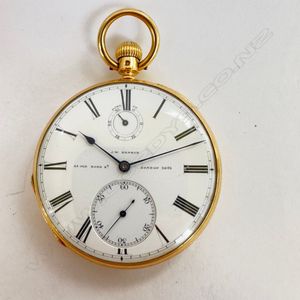
18ct Gold Open Face Half-Chronometer Pocket Watch by J. W. Benson
18ct gold open face 'Half-chronometer' pocket watch by J. W. Benson, 25 Old Bond St., London. Number 1091. Fine, signed and numbered white enamel dial, with 0-30 hour up/down dial at XII, sunken subsidiary seconds at VI, black Roman numerals, blued steel…

J W Benson Sterling Silver Pocket Watch with Chain Key
J W Benson sterling silver pocket watch with chain and winding key. 54.0 mm case diameter with white Roman numeral dial and seconds sub dial at 6 o'clcok. Stamped J W B & lion passant inside denotes sterling silver, and the leopard's head: the town mark…

J.W. Benson Half Hunter Pocket Watch with Original Case
9ct yellow gold, signed J W Benson, Ludgate hill half hunter pocket watch with original case/sleeve and warranty on leather attachment with rose gold buckle and swivel clasp fittings. A superb piece. 52 mm case, hallmarked J. W.Benson Ltd Ludgate hill.…
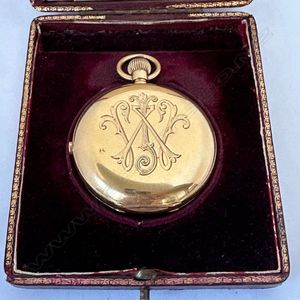
18ct Gold Hunter Chronograph Pocket Watch by J.W. Benson
18ct gold hunter chronograph pocket watch by J.W. Benson, number 266755 51 mm plain case stamped with Swiss bureaux de controle - three heads of Helvetia, (from 1887), the higher standard of 0.755' for 18ct gold watch cases exported to the UK. The hinged…

J.W. Benson 18ct Gold Hunter Pocket Watch
18ct gold hunter pocket watch, by J.W. Benson, London 52 mm case, hallmarked 1908, presentation engraved to back. Signed white enamel dial with Roman numerals, railtrack minutes, subs seconds dial. Internal 18ct gold dust cover. Lever escapement movement,…
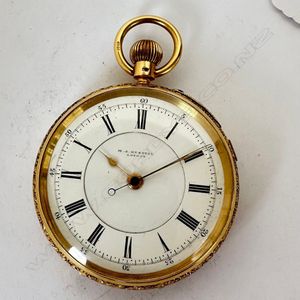
18ct Gold Pocket Watch by M.J. Russell, London
Substantial 18ct gold, open face pocket watch by M. J. Russell, London, number 12189, 54 mm case, with inner 18ct gold dust cover, hallmarked Chester 1899 by Benson Brothers (John & William H Benson), watch case manufacturers, Wood Street, Liverpool.…
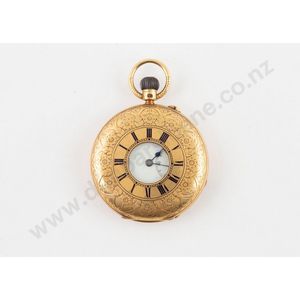
J.W. Benson Half Hunter Pocket Watch #2559
18ct half hunter cased lever wind pocket watch 3/4 plate 'The Field' by J W Benson, London #2559
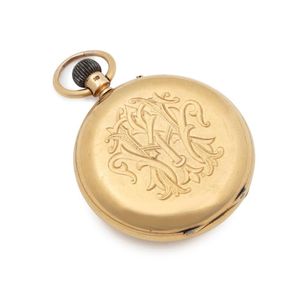
J.W. Benson 18ct Gold Pocket Watch, Engraved Hunter Case
An 18-carat gold pocket watch, J. W Benson, English, 1899, 3/4 plate, lever escapement, blue steeled hands, enamel dial, subsidiary seconds, 18 carat gold hunter case with engraving., 50 mm diameter

J.W. Benson Enamel Pocket Watch, London 1883
A sterling silver pocket watch, enamel dial, inscribed 'Watch maker by Warrant to the Queen J.W.Benson London' London 1883. Mounted on a metal chain.

Frederick Miller Verge Fusee Pocket Watch with Provenance
A pair case pocket watch, the verge fusee movement signed by Frederick Miller of 38 Greek Street, Soho, with engraved movement and pierced and engraved balance cock. The cap signed Bery Baker and inner and outer case hallmarked London 1973. Watchpaper…

Sterling Silver Airman's Fob Watch by J.W. Benson, London
J W Benson sterling silver airman's fob watch, London

Jw Benson Silver Pocket Watch with Queen Victoria Marking
An Edwardian silver open face pocket watch by Jw Benson, London, marked to Queen Victoria. The Ludgate watch. Patent no. 4658. No 18192., ¾ plate lever movement. Working allmarks dated 1904.

Victorian Silver Fob Vesta with Trick Opening
Victorian sterling silver Trick opening vesta, hallmarked London, 1876, Jb (John Batson), inscribed 'Benson & Hedges old Bond Str' to interior lid, in the form of a fob watch, with engine turned decoration and central medallion with monogram, total weight…

J.W. Benson 9ct Gold Pocket Watch with Original Box
A gents pocket watch by J W Benson of London, 9ct yellow gold case with London assay marks circa late 19th early 20th century fitted with Swiss movement with original makes box
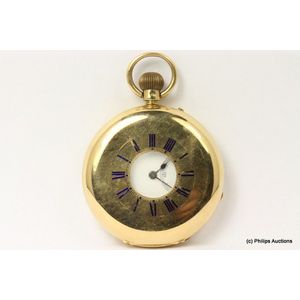
J.W. Benson Gold Pocket Watch 1888 Royal Engraving
A gents gold demi cased pocket watch, 18ct yellow gold, marked to dial, J.W. Benson London, engraved to case 1888, engraved to movement to H.M. The Queen & H.R.H. The Prince of Wales. J.W, Benson 62 & 64 Ludgate hill London, movement no, 102764, with…

JW Benson 9ct Gold Half Hunter Pocket Watch 1928
J W Benson 9ct gold half hunter watch white enamel dial with black roman numerals, with seconds subsidiary dial. 50 mm case. Stem wind, Total weight 94.5gms. Stamped 9ct 375. Hallmarked to case back 1928. Working when tested.
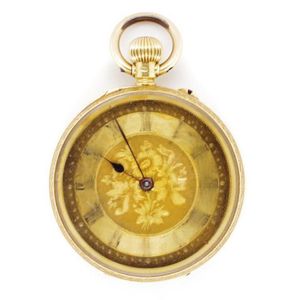
Antique 18ct Gold Ladies Pocket Watch by J.W. Benson
Edwardian 18ct gold ladies pocket watch. Movement marked J.W Benson 62 & 64 Ludgate Hill London Swiss Made by Warrant to HM The late Queen Victoria, marked 18k Swiss Helvetia to crown, back plate and case. Painted numerals are faded dial for restoration

1885 London Hallmarked JW Benson Open Face Pocket Watch
Silver JW Benson open face pocket watch, with key, hallmarked London 1885, maker JWB

J.W. Benson 18ct Gold Pocket Watch with Enamel Dial
Gent's 18ct gold J.W. Benson 'The Field' watch, half hunter pocket watch, hallmarked London 1919, with white enamel dial and subsidiary seconds dial, the gilt keyless movement marked 'I8227 the Field Best London Make By Warrant to HM the Queen J.W.Benson…
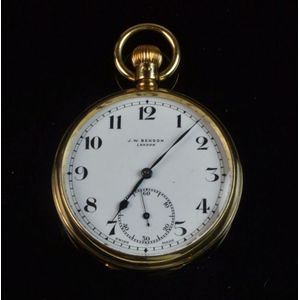
Functional J.W. Benson 9ct Gold Pocket Watch
9ct yellow gold J. W. Benson pocket watch working and in very good condition 75.70 grams

J.W. Benson Half Hunter Pocket Watch with Display Box
18ct half hunter cased lever pocket watch white enamel dial by J W Benson, London 3/4 plate No103086 with original display box
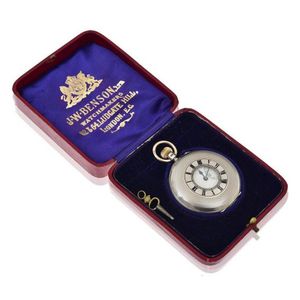
J.W. Benson Half Hunter Pocket Watch with Original Box
A sterling silver half hunter pocket watch by J.W. Benson, key wind and set, circular white enamel dial with Roman numerals, subsidiary seconds dial at six, engine turned sterling silver case, hallmarked, with original box. Condition: Presents in very…

Victorian Gold Pocket Watch by J.W. Benson
A fine Victorian gold consular case pocket watch, 1879, hallmarked case London 18ct gold with three quarter plate fusee and chain drive lever movement N.33815. Signed J. W. Benson 25 old Bond Street, London. Enamel dial with 'Up and down' in good order.…
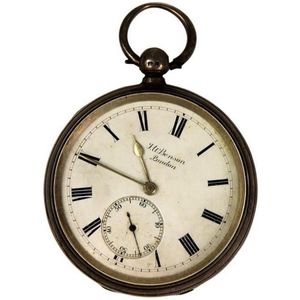
Victorian Benson Silver Pocket Watch Half Hunter Keywound
J. W. Benson 'Ludgate' English hallmarked sterling silver Victorian pocket watch keywound half hunter, a white dial with black Roman numerals, no. 75404, patent 75404. London, 1898, maker James William Benson condition good to fair, needs a service, some…

J.W. Benson Half Hunter Pocket Watch, 9ct Gold
9ct yellow gold, J W Benson, half hunter gents pocket watch, early 20th century Birmingham assay marks top wind movement white enamel dial with subsidiary second hand. Diameter 50 mm

18ct Gold Ladies Pocket Watch with Albertina Chain
18ct yellow gold ladies pocket watch, c.1900, top wind movement white enamel dial with subsidiary second hand movement engraved 'Examined by J.W. Benson...' cased stamped 18ct. Diameter 34 mm, with 18ct yellow gold fancy Albertina chain (19grams), with…

J.W. Benson 18ct Gold Pocket Watch & 9ct Albert Chain
A J.W.Benson 18ct gold hunting case pocket watch and 9ct gold Albert chain

J.W. Benson Sterling Silver Pocket Watch Case (1882)
A J. W. Benson sterling silver Roman dial pocket watch case maker is JW Benson Ltd, London 1882. Diameter 4.5 cm.

J.W. Benson 18ct Gold Pocket Watch with Display Case
J.W. Benson, the Doctor's field watch, 18ct yellow gold keyless wind full hunter pocket watch, case number 856, 'By Warrant To The Late Queen Victoria', includes a display case, total weight of 116 grams

J.W. Benson Open Face Pocket Watch, 1901
18ct yellow gold open face pocket watch manual key wind movement white enamel dial with subsidiary second hand fusee movement by J. W. Benson London case assayed Sheffield 1901. Diameter 47 mm, with service receipt May 2014

J.W Benson 9ct Gold Pocket Watch, 1926 Swiss Made
A gent's full hunter pocket watch, 9ct yellow gold, with a plain polished outer case, crafted by Messrs J. W Benson of London, featuring a white enamelled dial and black Roman numeral hour markers and a subsidiary seconds dial and 6 o'clock. The watch is…
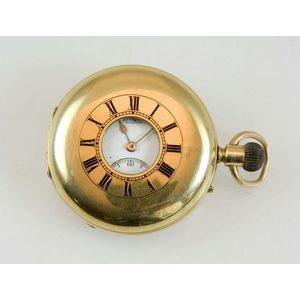
J.W. Benson 18ct Half Hunter Pocket Watch
18ct half hunter cased pocket watch no 240993 'The Field Watch' by J W Benson, London, white enamel dial with seconds movement, blue enamel outer dial Roman numerals, lever wind, marked Sheffield 1919 engraved with name and fern fronds
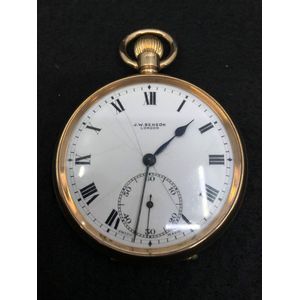
 Loading more...
Loading more...